The first book I read in 2014 was ‘WOLF HALL’, by Hilary Mantel. It’s long and was quite a challenge but I suddenly found myself ‘in step’ with it after about 200 pages. And, by chance, I started 2015 with another long but ultimately satisfying piece of writing. ‘THE GOLDFINCH‘ by Donna Tartt.
This starts off with a ‘bang’ which filters out into an extraordinary, sprawling panorama of a book.
The day I bought a copy was when I’d been to see a Vermeer exhibition at The National Gallery. I knew that Vermeer was supposedly mentored by Carel Fabritius, who himself studied under Rembrandt. But Fabritius died young, a victim of the massive explosion of the Delft gunpowder magazine in 1654. Many of the paintings in his studio were also destroyed but from what art historians say, he was destined for greatness. One of the paintings that did survive is called ‘The Goldfinch’, which was on show in the Vermeer exhibition.
I stood in front of it for a while, thinking of all the untimely accidents that happen and how they affect futures that might have turned out very differently, for not only the victim but for those he/she knew and for the world in general. What if …
On my way home I slipped into Waterstones. The first book I saw, laid out on a table, had a jacket with Fabritius’s goldfinch on the front. I felt in visceral shock, as if my heart had stopped. The title was ‘THE GOLDFINCH’ by Donna Tartt. I wasn’t to know then that the book starts with a terrible accident – creating the effect of a stone thrown into a pond. It’s a wonderful read – long, but once started, bowls along.

‘The Goldfinch’ by Donna Tartt
Patrick Modiano has won the Nobel prize for literature. I had already read three of his novels (in the original French) at my class. ‘UN CIRQUE PASSE’ continues the theme which runs through his novels about ‘untold’ stories and ‘lost’ people. Many of these people were ‘lost’ during and after World War 2. This novel is set in Paris as the war continues and a young boy and girl with her dog are thrown together, their lives fractured, having lost touch with their families. Atmospheric, sinister, mysterious, tense and sad … there is also romance and you wish for a happy ending …
I continued with ‘Maigret’ (Simenon) in French and read ‘LES VIEILLARDS’ (1960). A former diplomat in his fading years, living in retirement discreetly behind Parisian closed doors, with only an ageing and devoted housekeeper for company, is found shot. His life seems to have been unimpeachable, except for a long standing but curious platonic love affair with a woman, Isabelle, with whom he exchanged letters almost daily since he was a young man. Maigret investigates.

Books in French – Modiano and Simenon
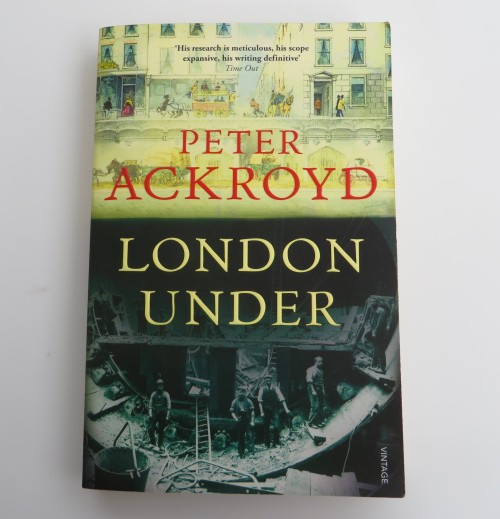
‘LONDON UNDER’ by Peter Ackroyd. He’s written some wonderful books, many on the city of London. In this one he makes you aware of how London is built on so many wells and springs. It makes for a fascinating read, especially when you are out and about and can track down some of these wells and springs – or remains of – with your trusty A-Z.
“The plethora of London names such as Spring Gardens, Well Walk and Wells Street testifies to the extent and variety of these waters. We also have Shadwell and Stockwell and Camberwell”. And so it goes”. On its journey to the Thames, the Westbourne river passes through a great iron pipe today, to be seen above the platforms of Sloane Square tube station.”
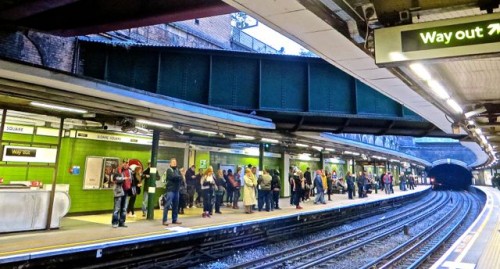
The river Westbourne passing above Sloane Square station
Afterwards, I went for another non-fiction read. ‘STUFF MATTERS’ by Mark Miodownik. I needed to read this twice to remember it – ‘Stuff’ indeed really does matter and we should be aware of what we can do with, for example, futuristic materials like graphene and aerogel. Afterwards, I felt more or less up to date with ‘The Strange Stories of the Marvellous Materials that shape our Man Made World’. A great scientific learning experience. Since I read this MM has presented programmes on television, following his book.
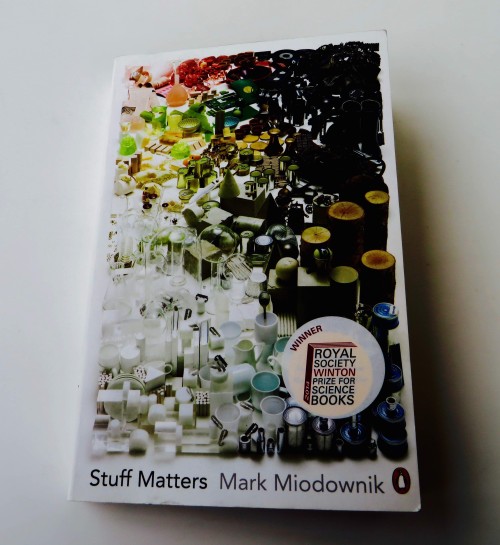
Concentration here reaps rewards …
Somebody suggested I read a novel about exploring nature. ‘THE FISH LADDER’ by Katharine Norbury has very memorable descriptions about the countryside as she indomitably strides on through it, day and night, but she would not be my type of travelling companion.
I read an American novel soon after this one, called ‘AQUARIUM’ by David Vann. This is grim reality – but seen through the surreal world of a young girl. ‘Jellyfish eyes’ (page 51). It’s very dark – peeking at the obverse side of the American dream with the aquarium as focus, where Caitlin is obsessed with the maritime creatures. Is the old man who she meets there other than he seems? It’s an ongoing struggle, not just for survival but to understand the adults around her and help them find a life rather than just an existence. An uplifting read, despite much of it on the dark side.
Both of these books made me feel somewhat like this picture of them. Unbalanced – on the edge …probably good to be out of one’s comfort zone!
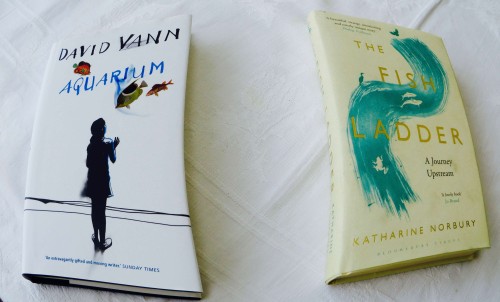
I loved this next book. ‘PERFECT WIVES IN IDEAL HOMES’ – ‘The story of women in the 1950s’, by Virginia Nicholson. I raced through it with many of the stories resonating so strongly with my own experience of the 1950s and 60s – like being a teenage beauty queen at Butlin’s holiday camp! How things have changed – for better or worse – or both. Very well researched and tells it as it was. It hit such a nostalgic note for me. And am still doing the housework … but I do have time to read nowadays…
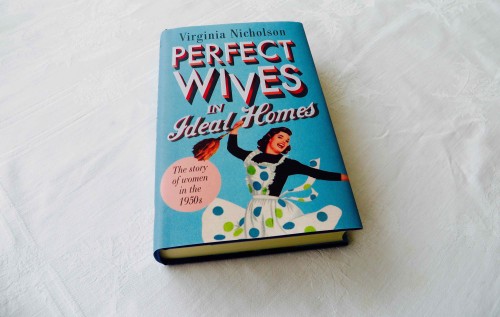
Enormously enjoyable …
It was about this time that an American friend of John’s, Debra Dunne, who is a food scientist, arrived in London and over lunch at Zédel’s, she recommended a book ‘SALT, SUGAR, FAT – HOW THE FOOD GIANTS HOOKED US’ by Michael Moss. Yes, they certainly did – and do. I lapped it up!
The author tells us that every year the average American eats 33lbs of cheese (triple what we ate in 1970) and 70 lbs of sugar (about 22 teaspoons a day). Also that we ingest 8,500 mg of salt a day – double the recommended amount and this mainly comes from eating processed food. It’s no wonder that 26 million Americans have diabetes 2. The level of obesity among humans today is beyond belief – and continues to grow. Most of this has happened in the past 60 years.
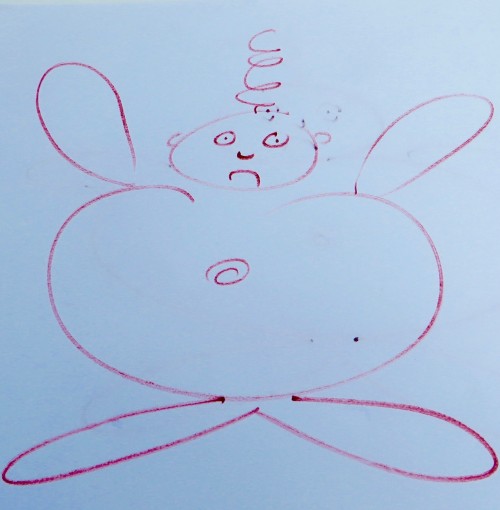
Help!
I came down with a terrible cold and actually spent two days in bed. Unheard of for me, but it was comforting, pampered by my oh- so- soft duvet. I began to find it quite relaxing. From time to time I ventured downstairs to fill up my mug with restorative hot lemon juice, honey and whisky. And I found a perfect book to read when my eyes stopped streaming.
‘THE BLACK EYED BLONDE’ is a Philip Marlowe lookalike novel, set in the 1950s and written by Benjamin Black, a pen name for John Banville. Very ‘noir’, with its laconic detective once more in edgy company of a beautiful, rich woman who wants him to solve a murder case while treacherously tempting him to sleep with her. A spider in her web …
John Banville won the Booker prize for ‘The Sea’ in 2005 but alongside his other novels, he wrote detective stories as Benjamin Black. Humphrey Bogart’s ghost is strongly in evidence.
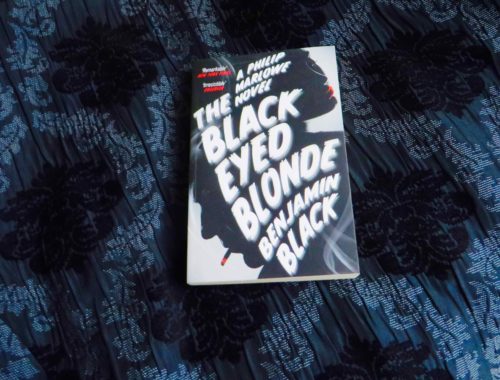
Shades of Bogart …
Another writer, Sophie Hannah, takes on the Agatha Christie style of writing with ‘THE MONOGRAM MURDERS’. I bought the hardback, lured by its glamorous gold and black cover and endpapers. It was good but somehow not quite what I had hoped for – but nevertheless, a great ‘try’. I love my handsome copy and would gladly read another by her.
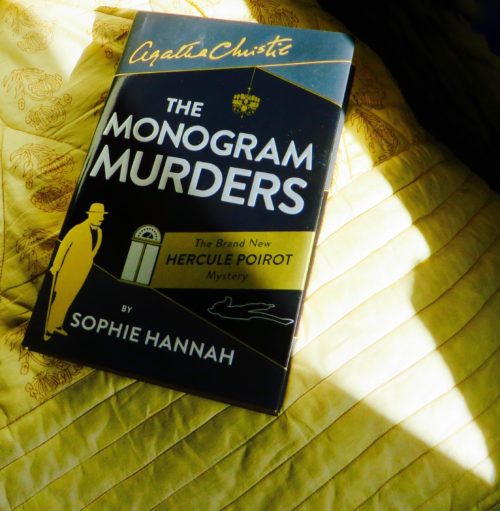
The Monogram Murders by Sophie Hannah
Feeling better now, I needed to jump out of my comfort zone.
What better than a travel book with a philosophical strand to it. Michael Jacobs, the author, who studied art at the Courtauld, fell in love with Spain. He was, for some years, a guide with ACE, a travel company. We had hoped to join a group where he would take us to the Alhambra, the huge mosque at Cordoba and to Toledo, where El Greco spent most of his life and did some of his best paintings. Sadly, it was not to be.
The title of this book, ‘THE ROBBER OF MEMORIES’, relates to his parents, both of whom died of dementia. But the story is about his dangerous trip up the Magdalena river in Colombia, dangerous not only because of the impenetrable jungle with its snakes and poisonous insects but also because of the FARC guerrillas, who made it their hideout.
MJ was lucky to survive. I’m glad I only travelled by armchair but also glad I was with him in spirit on this intensely personal journey. Later, MJ died of cancer before he was able to finish a book on the famous painting, ‘Las Meninas’ by Velasquez – a painting which obsessed him. A good friend finished the book for him after MJ’s death.
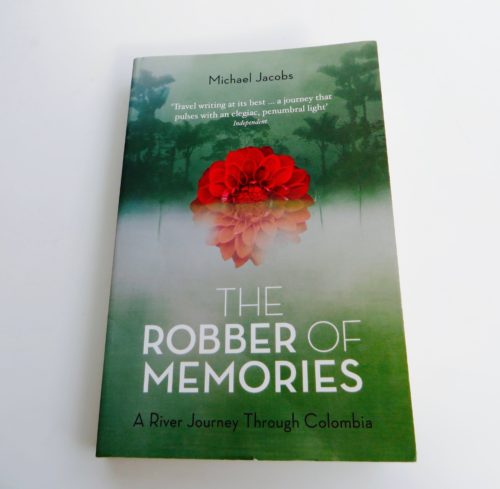
‘Carpe diem’
Dwelling on death, I decided to read ‘REASONS TO STAY ALIVE’ by Matt Haig. Oh, my! I don’t know if I would have survived this ordeal of deep, dark depression. It is brave of Matt Haig to relate what he went through. Others caught up in a similar situation may benefit from reading it. I hope so. His parents and girlfriend were saints and because of them, he made it.
And he wrote ‘THE HUMANS’, which I love. It is an original take on life on earth – completely original, off the wall entertaining. Yet so insightful about the human condition. What a star!

So glad you made it …
This next book was recommended. ‘EUPHORIA’ by Lily King. It’s an ‘anthropological’ novel set in New Guinea and based on the book ‘MARGARET MEAD – A LIFE’ by Jane Howard. It’s a good read and knowledgeable about tribal cultures. These can be very different, with a fierce and murderous tribe living quite near to a gentle and altruistic one. Biodiversity rules?!
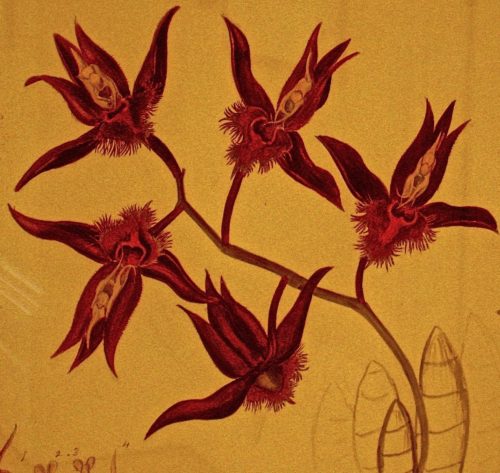
Jungle secrets …
This book reminded me of Ann Patchett’s ‘STATE OF WONDER’, which is a similar novel about a scientist doing research in a rain forest, who gets lost and is presumed dead. I preferred this novel because I felt a lot more in tune with all the characters and really cared about the outcome.
I had never read ‘TRAVELS WITH CHARLEY’ by John Steinbeck. I found it by chance in Waterstones Piccadilly and being a person with itchy feet for exploring, I picked it up with the anticipation of a good road trip. John Steinbeck is one of the ‘great’ writers of our time. This is a compelling read, written by a very intelligent ‘hobo’ (!), whose dog is pretty intelligent too. Charley is a French poodle without the frills and possessed of excellent instincts. I’d like to travel with Steinbeck and Charley again … I missed them as they turned the corner to home and disappeared from my life.
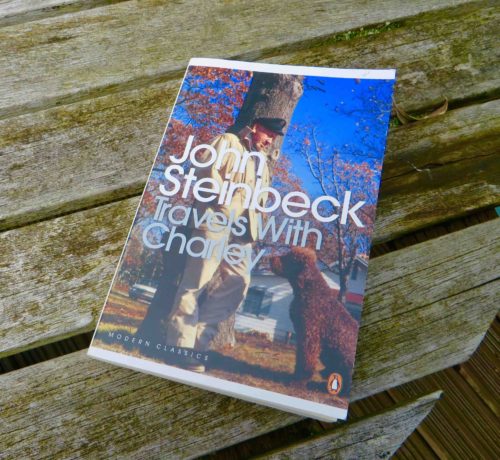
Travels with Charley – Steinbeck
Waterstones were bringing out some old classics in new jackets. Somehow, I had never read ‘THE BALKAN TRILOGY‘ and ‘THE LEVANT TRILOGY’ by Olivia Manning, although I remember the television series with Kenneth Branagh and Emma Thompson as Guy and Harriet Pringle. So many of my friends said how envious they were of me because it was such a treat in store. And so I began … 1033 pages, followed by another 569.
I wonder why Olivia Manning is not so well known today as other writers of her period, like Iris Murdoch. ‘THE BALKAN TRILOGY’ starts as Guy and Harriet Pringle, recently married, travel out to Eastern Europe at the start of World War 2, where Guy will be working as a lecturer with the British Council. The story follows their fortunes as war spreads and engulfs them.
Olivia Manning bases both books on her own experiences. She is acutely observant and as ‘The Guardian’ noted on the back of my book ‘One must salute the brilliance … the exactness of sights and sounds, the precise touches of light and scent, the gestures and entrances’. And I would like to add that Guy Pringle is one of the best delineated characters in modern fiction – and the marriage of Guy and Harriet, so finely dissected, means they can never be forgotten. I recognise some of the traits in my own marriage.
Instead of more explanation, I should direct you to the site of Abigail Nussbaum, whose commentary on both books (2010) is outstanding. Don’t read it before reading the books! I feel another trilogy could have been gestating in OM’s head but as ‘THE LEVANT TRILOGY’ was published in the year of her death (1980), I expect we missed that treat. Oh dear, my friends were right. I felt bereft when I came to the end, like saying farewell for the last time to people I had known and grown fond of. 100% recommended!
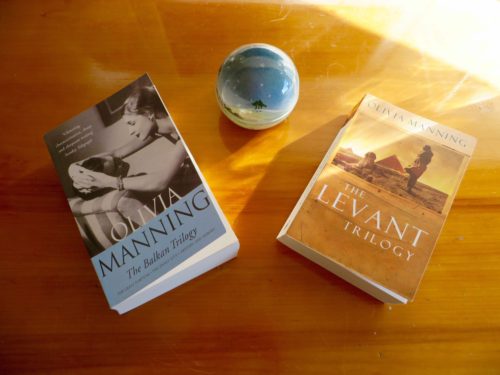
Not be be missed …
We decided to do a big clear out of books which had accreted over thirty plus years. Ten boxes went to the Oxfam shop in Chiswick, who accepted all of them. Hurrah – thank you, Oxfam. Then we rearranged hardbacks and paperbacks. I collected all the Graham Greenes together and decided to read ‘STAMBOUL TRAIN’. His characterisations are both skilful and memorable but personally I much prefer Paul Theroux’s train journeys. No criticism, just a personal choice – perhaps because PT is more of my era. Both of them tricky men in real life, I would think …
John bought ‘THE MARTIAN’ by Andy Weir. It’s not a book I would have picked up in the shop but despite all the technical detail, I found it fascinating and could hardly wait to find out the ending. An astronaut gets left on Mars by mistake, following an accident. The story is about how he survives – or not. A successful film has been made since.

Potatoes play a major role on Mars … !
I needed to get back to earth, to my own, green planet. I was drawn to ‘THE LAND WHERE LEMONS GROW‘ by Helena Attlee. What a pleasurable discovery!
It’s both a well researched history of the enormous variety of citrus trees grown through the ages with fillips of intriguing stories tossed into the mix. There is also a wealth of personal detail as the writer travelled over southern Europe, meeting all kinds of people connected with citrus and adding all sorts of recipes for marmalade and pasta. One which especially appeals is ‘Tagliolini alla Scorzette di Arancia e Limone’.
I can’t tempt you more than Jonathan Keates in the ‘Literary Review’ saying ‘every lemon-scented page made me feel it’s time to pack for Italy’ or Tom Stoppard in ‘The Times Literary Supplement’ – ‘The book I pressed on friends more than any other this year’. Added to that ‘The Guild of Food Writers’ chose it as ‘Food Book of the Year 2015’.
So you have to buy it and read it and try one of the recipes, (although I quickly turned over the page at ‘Tortoise Pie’)! Take the book as a companion on your travels – open it at any page and you have a wealth of fascinating anecdotes at your fingertips.
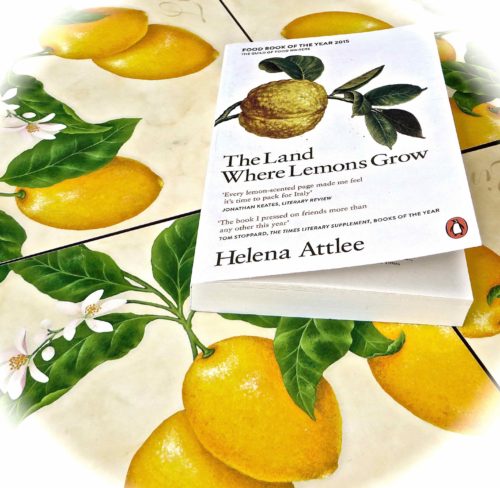
Land of Lemons
‘THE VERSIONS OF US’ by Laura Barnett. This is a novel about however many times you get the chance to change – have a re-run, make another choice, some people still make an enormous mess of their lives. I didn’t enjoy this at all and was very turned off by all the characters. It went to the charity shop and as it seems to be popular, I hope it went to a home of somebody who loved it.
Sue Roe is a writer after my own heart. I am a great lover of paintings and ‘THE PRIVATE LIVES OF THE IMPRESSIONISTS’ is such a rewarding read. It’s a very personal and detailed account, so much so that I felt I was living alongside the artists. She nails your interest from the very first sentence, creating a luminous backdrop for the artists of Paris and the Seine. The blurb comments, ‘This intimate, colourful, superbly researched account takes us into their homes and their studios and describes their unconventional, volatile and precarious lives, as well as the stories behind the paintings’.
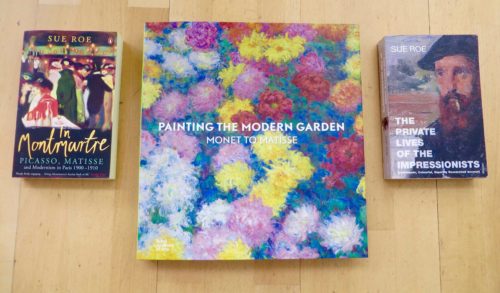
I was so entranced that I bought another book by her, called ‘IN MONTMARTRE’. This is all about Picasso, Matisse et al arriving penniless in Paris, where the ‘high pitched chaos’ of living in the Bateau Lavoir is shatteringly and wonderfully portrayed. The Spectator said of this book that it was ‘enjoyable, engaging, rollicking … lively’. Both books are worth a second read. They flow as easily as the Seine.
A friend bought me the catalogue of the ‘Gardens’ exhibition at the Royal Academy, which was on until recently. Painting outdoors instead of always in a studio became popular with the Impressionists and many artists, like Monet and Renoir, Pissarro, Caillebotte and Sorolla, le Sidaner, Bonnard and Rusinol, to name a few, took not only to painting gardens but to growing their own and exchanging visits to see one another’s. Monet’s garden at Giverny is a prime example, which many flock to today as his dream lives on. There is an interview between Monty Don and the present gardener, James Priest, in the catalogue. Monet lived at Giverny for 43 years.
Towards the end of the year I was beset by gastric problems and felt miserable. This was made worse by ‘the 100 day cough’, a beastly malady which meant that talking started off a machine gun rat-a-tat, so I began to speak less and less. Probably a relief for some!
I silently bought ‘GUT’ by the rather beautiful Giulia Enders, illustrated by her equally beautiful sister, which became a best seller – making me think that many people must suffer from gastric problems! There are no euphemisms here as she describes how your complex digestive system works. A great bathroom/bedside book. I learned so much about my innards!
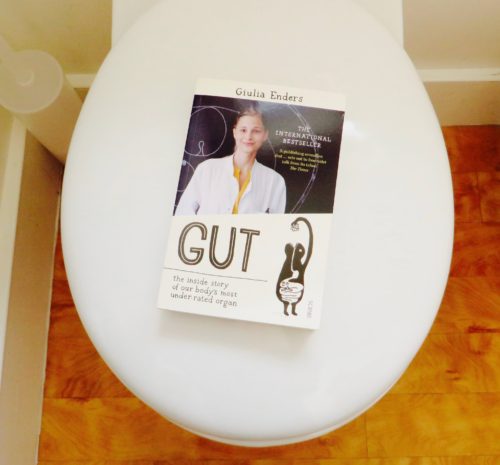
Could I possibly take on another long read after the Balkan and Levant trilogies? I had quickly skirted the table in Waterstones, which groaned under piles of the Elena Ferrante quartet for this very reason. Just don’t pick it up … what I really needed was even just a cookery book that I could dip in and out of to finish up the year. Or an Alastair Sawday book, full of beautiful chateaux and manor houses in France that offered B&B. I needed comfort on many levels.
But somebody arrived, bringing ‘MY BRILLIANT FRIEND’, the first book of the quartet, which by now was celebrating bestseller status – not that that means I would enjoy it. I said thank you, how kind … but resolved firmly to put it away until 2016 poked its head around the door.
However, the cough maundered on and one day, in the midst of cleaning the kitchen, I opened the first page out of curiosity. Just like Pandora’s Box! Casting mop and bucket aside, I read on …
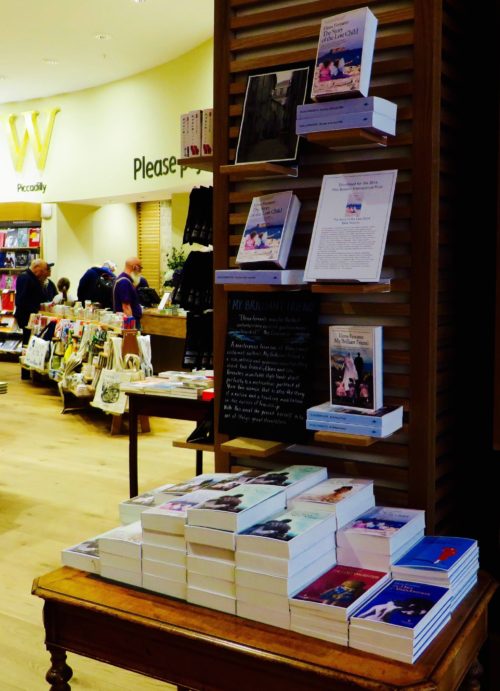
The Ferrante table at Waterstones
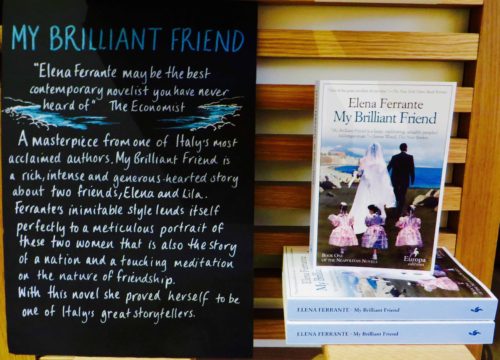
Book 1 – My Brilliant Friend
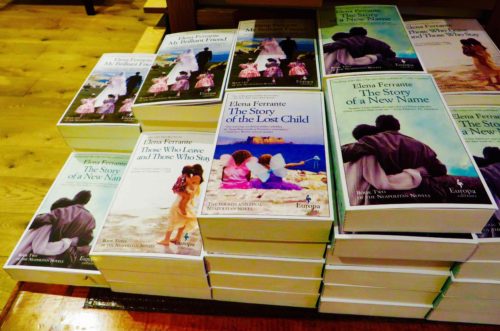
The Ferrante quartet – The Neapolitan novels
In order: ‘ My Brilliant Friend’, ‘The Story of a New Name’, Those Who Leave and Those Who Stay’, The Story of The Lost Child’.
I read these books voraciously, one after the other. Emotions run high, damaging people’s fragile lives; whirlwinds of love, lust, hate, loss, tempered by enduring friendships. Any advice that one might have given would have been ignored. But for all the family feuding, the leaving and returning, the loves and the losses, the loyalties and betrayals, there is an all pervading sense of belonging that connects the characters to one another and makes for an indelible story line. The ending (for me) sews it all up in one sentence.
The author is unknown as she will not give interviews or reveal who she is. I empathise with that. I think she herself must have struggled against the macho atmosphere and way of life in which she grew up to attain a university education and success as a writer. The Neapolitan novels are a wonderful read, a great achievement and will be remembered also as a valuable social document of the times we lived in.
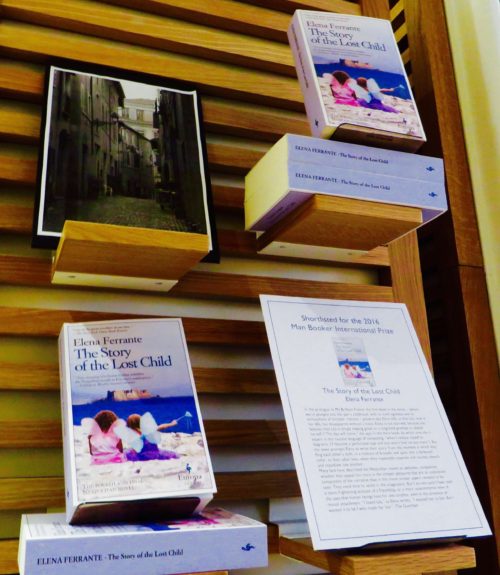
The Lost Child
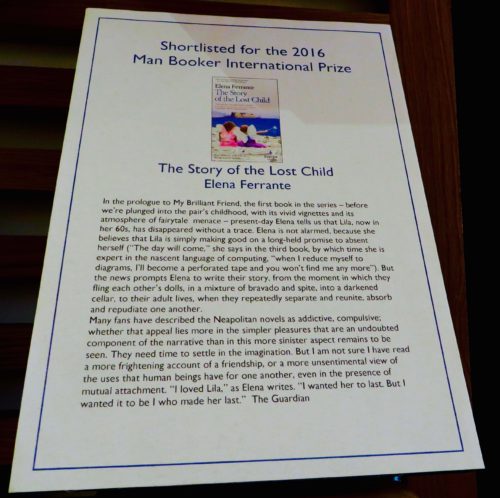
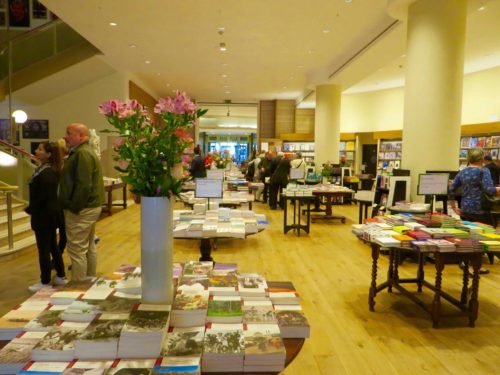
Waterstones – ground floor
Well, that’s it for 2015. Bookshops still exist despite Amazon and I would feel completely bereft without them. There are two on Piccadilly – Hatchards and Waterstones. James Daunt, an independent bookseller, was asked by Waterstones during lean times, to come in and try to revive their fortunes. He seems to have succeeded. Hurrah! He also has independent bookshops of his own. Daunts in Marylebone High Street is very special.
Waterstones now has two cafés and a restaurant of their own in the building, which become ever more popular, together with soirées, when authors come and talk about their books while you enjoy a glass of wine. Books, flowers, knowledgeable and friendly assistants on hand. A cup of coffee, a slice of cake. I can’t think of a better treat in store!

Welcome to bookshops 2016!

One Comment